YAMAHA YS125 2017 Workshop Manual
Manufacturer: YAMAHA, Model Year: 2017, Model line: YS125, Model: YAMAHA YS125 2017Pages: 90, PDF Size: 2.24 MB
Page 51 of 90
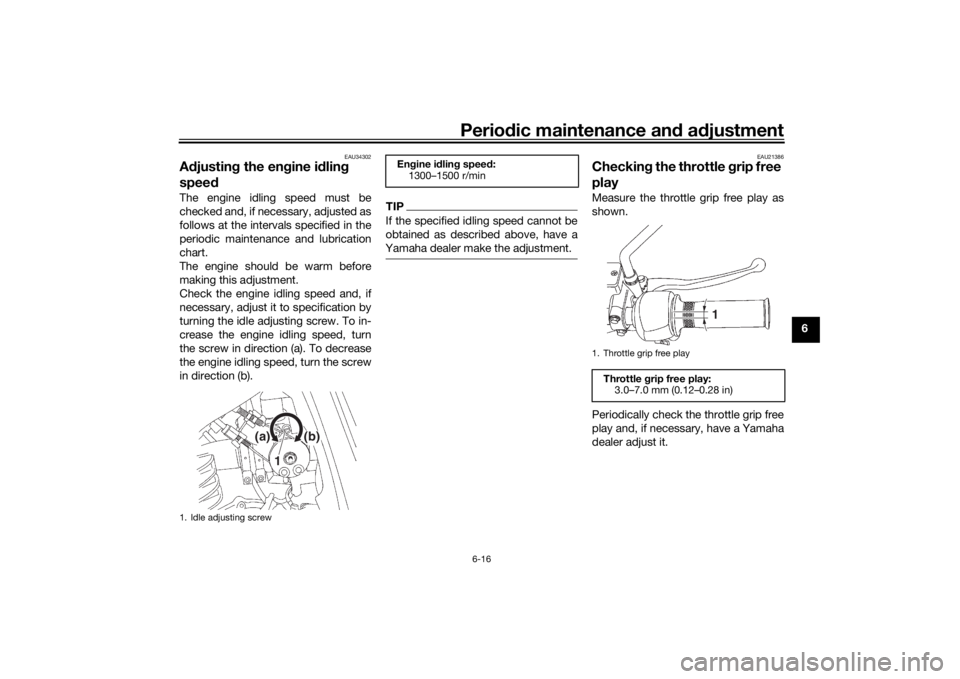
Periodic maintenance an d a djustment
6-16
6
EAU34302
A djustin g the en gine i dlin g
spee dThe engine idling speed must be
checked and, if necessary, adjusted as
follows at the intervals specified in the
periodic maintenance and lubrication
chart.
The engine should be warm before
making this adjustment.
Check the engine idling speed and, if
necessary, adjust it to specification by
turning the idle adjusting screw. To in-
crease the engine idling speed, turn
the screw in direction (a). To decrease
the engine idling speed, turn the screw
in direction (b).
TIPIf the specified idling speed cannot be
obtained as described above, have a
Yamaha dealer make the adjustment.
EAU21386
Checkin g the throttle grip free
playMeasure the throttle grip free play as
shown.
Periodically check the throttle grip free
play and, if necessary, have a Yamaha
dealer adjust it.
1. Idle adjusting screw
1
(b)
(a)
En gine i dlin g spee d:
1300–1500 r/min
1. Throttle grip free play
Throttle grip free play:
3.0–7.0 mm (0.12–0.28 in)
1
UBT4E0E0.book Page 16 Thursday, November 17, 2016 10:55 AM
Page 52 of 90
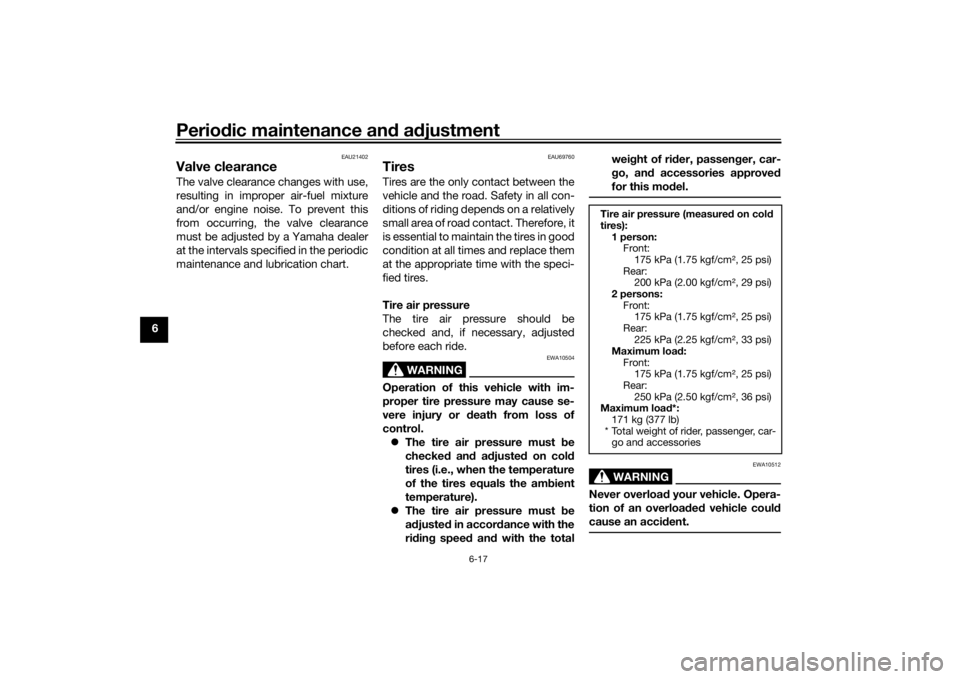
Periodic maintenance and adjustment
6-17
6
EAU21402
Valve clearanceThe valve clearance changes with use,
resulting in improper air-fuel mixture
and/or engine noise. To prevent this
from occurring, the valve clearance
must be adjusted by a Yamaha dealer
at the intervals specified in the periodic
maintenance and lubrication chart.
EAU69760
TiresTires are the only contact between the
vehicle and the road. Safety in all con-
ditions of riding depends on a relatively
small area of road contact. Therefore, it
is essential to maintain the tires in good
condition at all times and replace them
at the appropriate time with the speci-
fied tires.
Tire air pressure
The tire air pressure should be
checked and, if necessary, adjusted
before each ride.
WARNING
EWA10504
Operation of this vehicle with im-
proper tire pressure may cause se-
vere injury or death from loss of
control. The tire air pressure must be
checked and adjusted on cold
tires (i.e., when the temperature
of the tires equals the ambient
temperature).
The tire air pressure must be
adjusted in accordance with the
riding speed and with the total weight of rider, passenger, car-
go, and accessories approved
for this model.
WARNING
EWA10512
Never overload your vehicle. Opera-
tion of an overloaded vehicle could
cause an accident.Tire air pressure (measured on cold
tires):
1 person:Front:
175 kPa (1.75 kgf/cm², 25 psi)
Rear: 200 kPa (2.00 kgf/cm², 29 psi)
2 persons: Front:175 kPa (1.75 kgf/cm², 25 psi)
Rear: 225 kPa (2.25 kgf/cm², 33 psi)
Maximum load:
Front:175 kPa (1.75 kgf/cm², 25 psi)
Rear:
250 kPa (2.50 kgf/cm², 36 psi)
Maximum load*: 171 kg (377 lb)
* Total weight of rider, passenger, car- go and accessories
UBT4E0E0.book Page 17 Wednesday, December 21, 2016 11:06 AM
Page 53 of 90
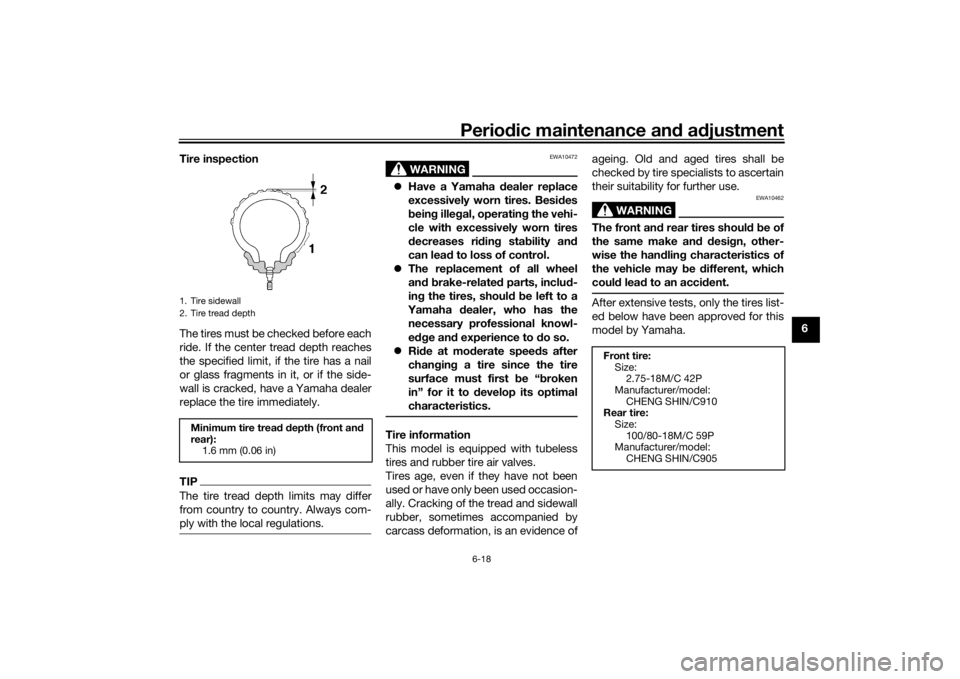
Periodic maintenance an d a djustment
6-18
6
Tire inspection
The tires must be checked before each
ride. If the center tread depth reaches
the specified limit, if the tire has a nail
or glass fragments in it, or if the side-
wall is cracked, have a Yamaha dealer
replace the tire immediately.
TIPThe tire tread depth limits may differ
from country to country. Always com-
ply with the local regulations.
WARNING
EWA10472
Have a Yamaha d ealer replace
excessively worn tires. Besi des
b ein g ille gal, operatin g the vehi-
cle with excessively worn tires
d ecreases ri din g sta bility an d
can lea d to loss of control.
The replacement of all wheel
and b rake-relate d parts, inclu d-
in g the tires, shoul d b e left to a
Yamaha dealer, who has the
necessary professional knowl-
e dg e an d experience to do so.
Ride at mo derate spee ds after
chan gin g a tire since the tire
surface must first be “ broken
in” for it to d evelop its optimal
characteristics.Tire information
This model is equipped with tubeless
tires and rubber tire air valves.
Tires age, even if they have not been
used or have only been used occasion-
ally. Cracking of the tread and sidewall
rubber, sometimes accompanied by
carcass deformation, is an evidence of ageing. Old and aged tires shall be
checked by tire specialists to ascertain
their suitability for further use.
WARNING
EWA10462
The front an
d rear tires shoul d b e of
the same make an d d esi gn, other-
wise the han dlin g characteristics of
the vehicle may be different, which
coul d lea d to an acci dent.After extensive tests, only the tires list-
ed below have been approved for this
model by Yamaha.
1. Tire sidewall
2. Tire tread depthMinimum tire trea d d epth (front an d
rear): 1.6 mm (0.06 in)
Front tire:Size: 2.75-18M/C 42P
Manufacturer/model: CHENG SHIN/C910
Rear tire:
Size: 100/80-18M/C 59P
Manufacturer/model:
CHENG SHIN/C905
UBT4E0E0.book Page 18 Thursday, November 17, 2016 10:55 AM
Page 54 of 90
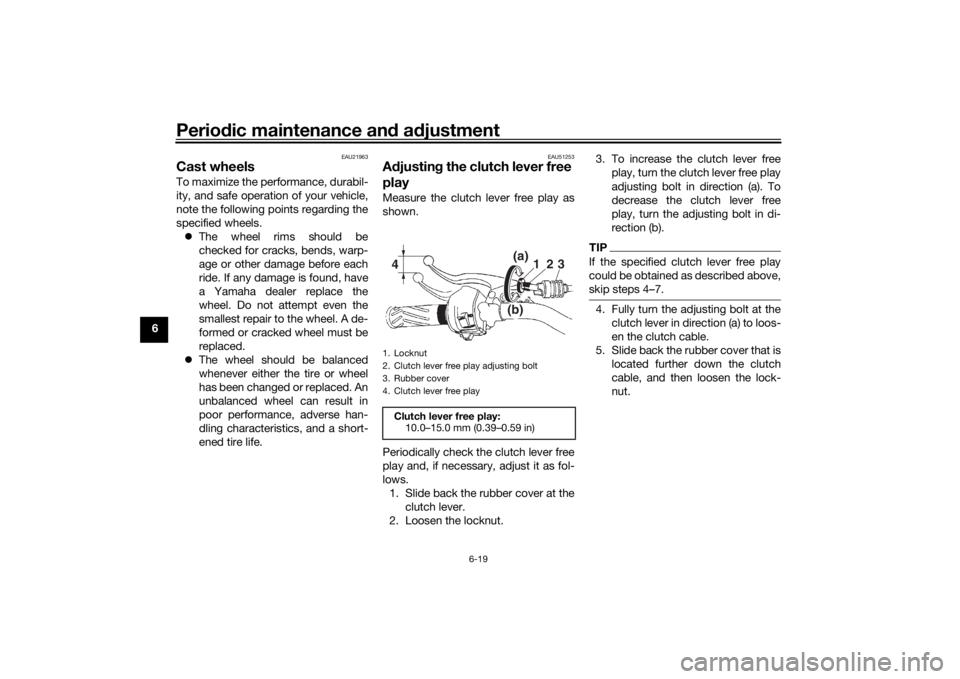
Periodic maintenance an d a djustment
6-19
6
EAU21963
Cast wheelsTo maximize the performance, durabil-
ity, and safe operation of your vehicle,
note the following points regarding the
specified wheels.
The wheel rims should be
checked for cracks, bends, warp-
age or other damage before each
ride. If any damage is found, have
a Yamaha dealer replace the
wheel. Do not attempt even the
smallest repair to the wheel. A de-
formed or cracked wheel must be
replaced.
The wheel should be balanced
whenever either the tire or wheel
has been changed or replaced. An
unbalanced wheel can result in
poor performance, adverse han-
dling characteristics, and a short-
ened tire life.
EAU51253
Adjustin g the clutch lever free
playMeasure the clutch lever free play as
shown.
Periodically check the clutch lever free
play and, if necessary, adjust it as fol-
lows.
1. Slide back the rubber cover at the clutch lever.
2. Loosen the locknut. 3. To increase the clutch lever free
play, turn the clutch lever free play
adjusting bolt in direction (a). To
decrease the clutch lever free
play, turn the adjusting bolt in di-
rection (b).
TIPIf the specified clutch lever free play
could be obtained as described above,
skip steps 4–7.4. Fully turn the adjusting bolt at theclutch lever in direction (a) to loos-
en the clutch cable.
5. Slide back the rubber cover that is located further down the clutch
cable, and then loosen the lock-
nut.
1. Locknut
2. Clutch lever free play adjusting bolt
3. Rubber cover
4. Clutch lever free playClutch lever free play:10.0–15.0 mm (0.39–0.59 in)
321
(a)(b)
4
UBT4E0E0.book Page 19 Thursday, November 17, 2016 10:55 AM
Page 55 of 90
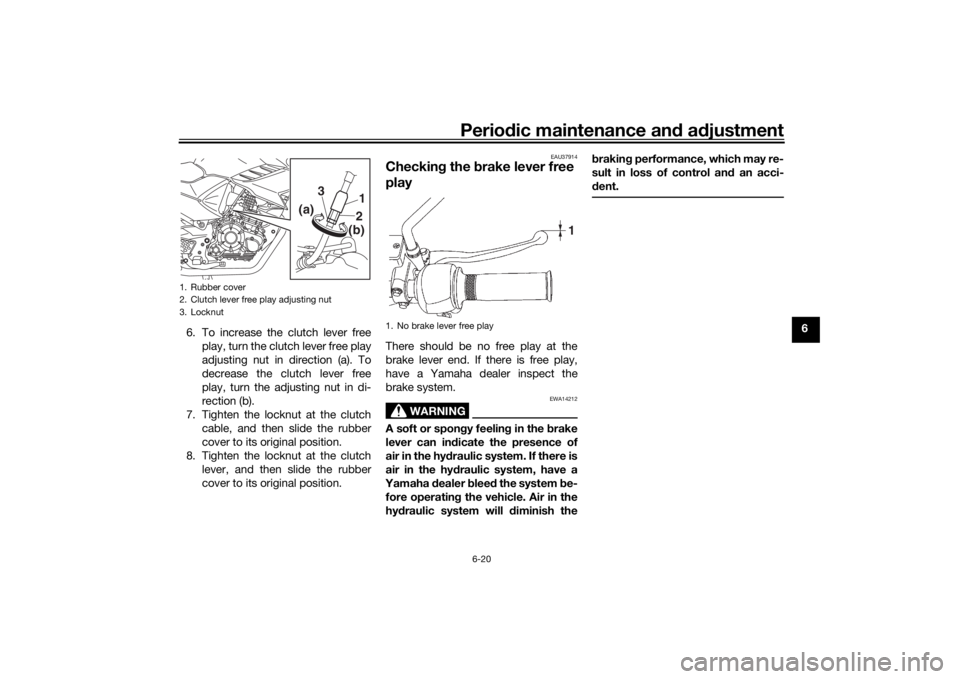
Periodic maintenance an d a djustment
6-20
6
6. To increase the clutch lever free
play, turn the clutch lever free play
adjusting nut in direction (a). To
decrease the clutch lever free
play, turn the adjusting nut in di-
rection (b).
7. Tighten the locknut at the clutch cable, and then slide the rubber
cover to its original position.
8. Tighten the locknut at the clutch lever, and then slide the rubber
cover to its original position.
EAU37914
Checkin g the brake lever free
playThere should be no free play at the
brake lever end. If there is free play,
have a Yamaha dealer inspect the
brake system.
WARNING
EWA14212
A soft or spon gy feelin g in the brake
lever can in dicate the presence of
air in the hy draulic system. If there is
air in the hy draulic system, have a
Yamaha dealer blee d the system be-
fore operatin g the vehicle. Air in the
hy draulic system will diminish the b
rakin g performance, which may re-
sult in loss of control an d an acci-
d ent.
1. Rubber cover
2. Clutch lever free play adjusting nut
3. Locknut
3
21(b)
(a)
1. No brake lever free play
1
UBT4E0E0.book Page 20 Thursday, November 17, 2016 10:55 AM
Page 56 of 90
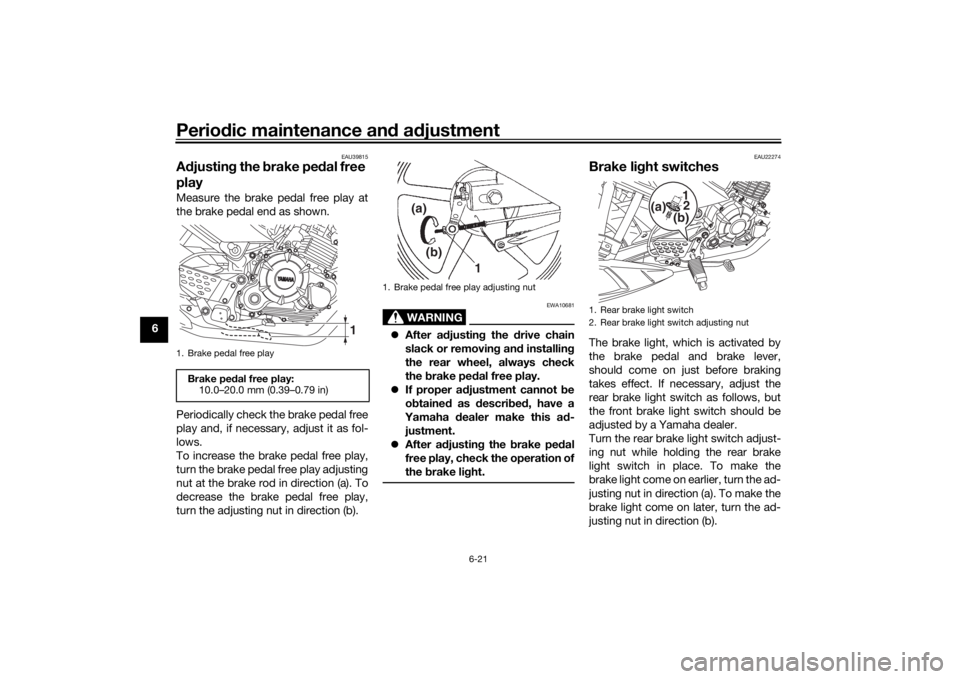
Periodic maintenance an d a djustment
6-21
6
EAU39815
A djustin g the brake pe dal free
playMeasure the brake pedal free play at
the brake pedal end as shown.
Periodically check the brake pedal free
play and, if necessary, adjust it as fol-
lows.
To increase the brake pedal free play,
turn the brake pedal free play adjusting
nut at the brake rod in direction (a). To
decrease the brake pedal free play,
turn the adjusting nut in direction (b).
WARNING
EWA10681
After a djustin g the drive chain
slack or removin g an d installin g
the rear wheel, always check
the brake pe dal free play.
If proper a djustment cannot b e
o btaine d as descri bed , have a
Yamaha dealer make this ad -
justment.
After a djustin g the brake ped al
free play, check the operation of
the brake li ght.
EAU22274
Brake li ght switchesThe brake light, which is activated by
the brake pedal and brake lever,
should come on just before braking
takes effect. If necessary, adjust the
rear brake light switch as follows, but
the front brake light switch should be
adjusted by a Yamaha dealer.
Turn the rear brake light switch adjust-
ing nut while holding the rear brake
light switch in place. To make the
brake light come on earlier, turn the ad-
justing nut in direction (a). To make the
brake light come on later, turn the ad-
justing nut in direction (b).
1. Brake pedal free playBrake pe dal free play:
10.0–20.0 mm (0.39–0.79 in)
1
1. Brake pedal free play adjusting nut
1
(a)
(b)
1. Rear brake light switch
2. Rear brake light switch adjusting nut
1 2
(a)
(b)
UBT4E0E0.book Page 21 Thursday, November 17, 2016 10:55 AM
Page 57 of 90
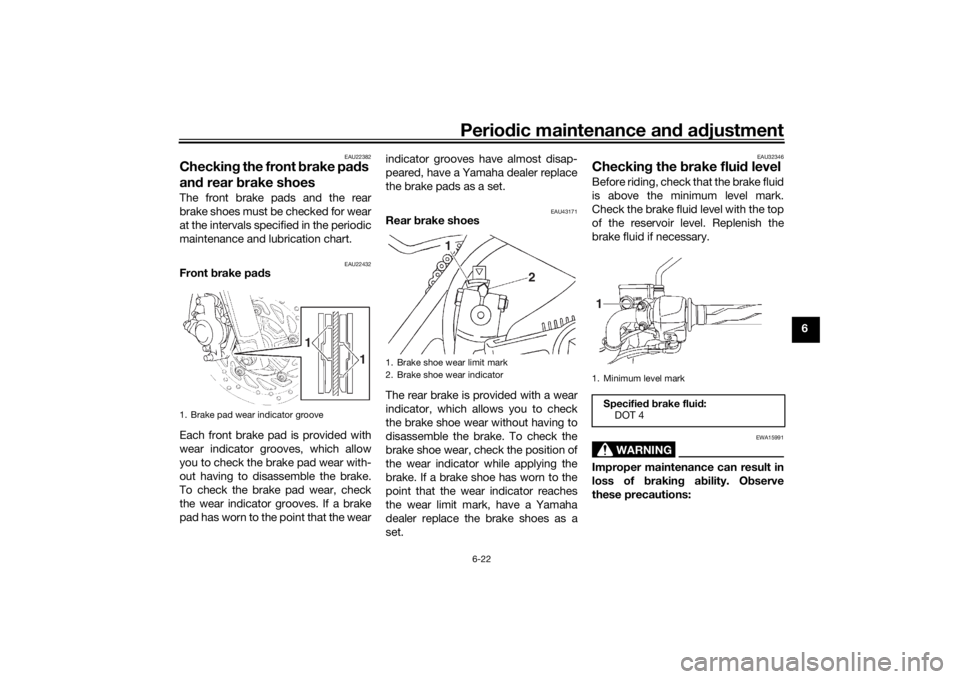
Periodic maintenance an d a djustment
6-22
6
EAU22382
Checkin g the front b rake pads
an d rear b rake shoes The front brake pads and the rear
brake shoes must be checked for wear
at the intervals specified in the periodic
maintenance and lubrication chart.
EAU22432
Front brake pad s
Each front brake pad is provided with
wear indicator grooves, which allow
you to check the brake pad wear with-
out having to disassemble the brake.
To check the brake pad wear, check
the wear indicator grooves. If a brake
pad has worn to the point that the wear indicator grooves have almost disap-
peared, have a Yamaha dealer replace
the brake pads as a set.
EAU43171
Rear
brake shoes
The rear brake is provided with a wear
indicator, which allows you to check
the brake shoe wear without having to
disassemble the brake. To check the
brake shoe wear, check the position of
the wear indicator while applying the
brake. If a brake shoe has worn to the
point that the wear indicator reaches
the wear limit mark, have a Yamaha
dealer replace the brake shoes as a
set.
EAU32346
Checkin g the brake flui d levelBefore riding, check that the brake fluid
is above the minimum level mark.
Check the brake fluid level with the top
of the reservoir level. Replenish the
brake fluid if necessary.
WARNING
EWA15991
Improper maintenance can result in
loss of b raking a bility. O bserve
these precautions:
1. Brake pad wear indicator groove
1
1
1. Brake shoe wear limit mark
2. Brake shoe wear indicator
1
2
1. Minimum level mark
Specified b rake flui d:
DOT 41
UBT4E0E0.book Page 22 Thursday, November 17, 2016 10:55 AM
Page 58 of 90
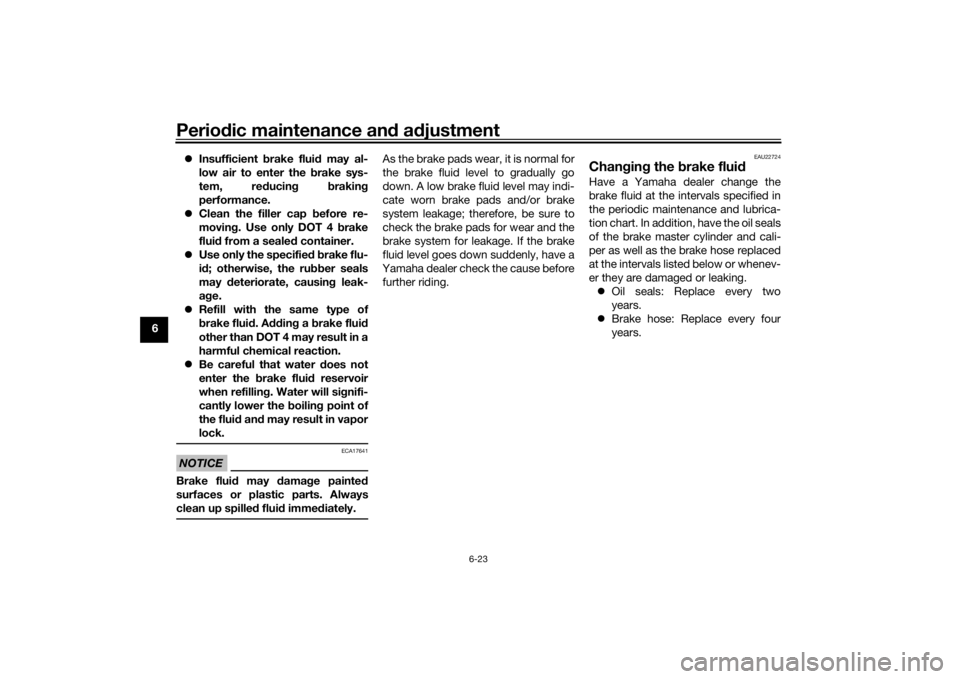
Periodic maintenance an d a djustment
6-23
6
Insufficient brake flui d may al-
low air to enter the b rake sys-
tem, re ducin g brakin g
performance.
Clean the filler cap before re-
moving . Use only DOT 4 b rake
flui d from a seale d container.
Use only the specified b rake flu-
i d ; otherwise, the ru bber seals
may deteriorate, causin g leak-
a g e.
Refill with the same type of
brake flui d. A ddin g a brake flui d
other than DOT 4 may result in a
harmful chemical reaction.
Be careful that water does not
enter the brake flui d reservoir
when refillin g. Water will si gnifi-
cantly lower the boilin g point of
the flui d an d may result in vapor
lock.
NOTICE
ECA17641
Brake flui d may damag e painted
surfaces or plastic parts. Always
clean up spille d flui d imme diately.
As the brake pads wear, it is normal for
the brake fluid level to gradually go
down. A low brake fluid level may indi-
cate worn brake pads and/or brake
system leakage; therefore, be sure to
check the brake pads for wear and the
brake system for leakage. If the brake
fluid level goes down suddenly, have a
Yamaha dealer check the cause before further riding.
EAU22724
Chan gin g the brake flui d Have a Yamaha dealer change the
brake fluid at the intervals specified in
the periodic maintenance and lubrica-
tion chart. In addition, have the oil seals
of the brake master cylinder and cali-
per as well as the brake hose replaced
at the intervals listed below or whenev-
er they are damaged or leaking.
Oil seals: Replace every two
years.
Brake hose: Replace every four
years.
UBT4E0E0.book Page 23 Thursday, November 17, 2016 10:55 AM
Page 59 of 90
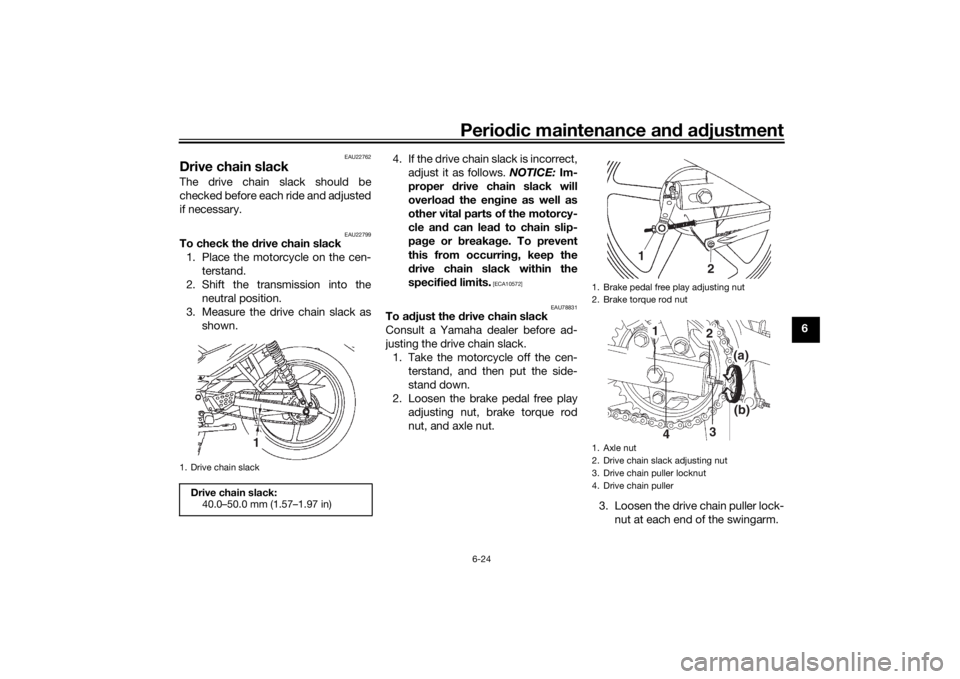
Periodic maintenance an d a djustment
6-24
6
EAU22762
Drive chain slackThe drive chain slack should be
checked before each ride and adjusted
if necessary.
EAU22799
To check the drive chain slack
1. Place the motorcycle on the cen- terstand.
2. Shift the transmission into the neutral position.
3. Measure the drive chain slack as shown. 4. If the drive chain slack is incorrect,
adjust it as follows. NOTICE: Im-
proper drive chain slack will
overloa d the en gine as well as
other vital parts of the motorcy-
cle an d can lead to chain slip-
pa ge or b reakag e. To prevent
this from occurrin g, keep the
d rive chain slack within the
specifie d limits.
[ECA10572]
EAU78831
To adjust the drive chain slack
Consult a Yamaha dealer before ad-
justing the drive chain slack. 1. Take the motorcycle off the cen- terstand, and then put the side-
stand down.
2. Loosen the brake pedal free play adjusting nut, brake torque rod
nut, and axle nut.
3. Loosen the drive chain puller lock-nut at each end of the swingarm.
1. Drive chain slackDrive chain slack:40.0–50.0 mm (1.57–1.97 in)
1
1. Brake pedal free play adjusting nut
2. Brake torque rod nut
1. Axle nut
2. Drive chain slack adjusting nut
3. Drive chain puller locknut
4. Drive chain puller
1
2
4 31
2
(a)(b)
UBT4E0E0.book Page 24 Thursday, November 17, 2016 10:55 AM
Page 60 of 90
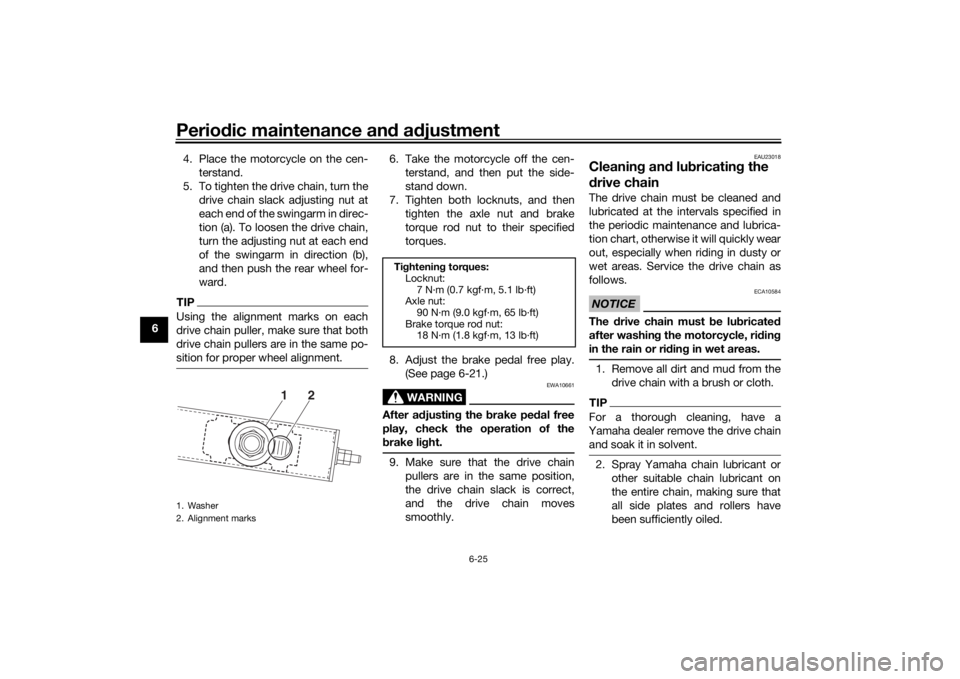
Periodic maintenance an d a djustment
6-25
6 4. Place the motorcycle on the cen-
terstand.
5. To tighten the drive chain, turn the drive chain slack adjusting nut at
each end of the swingarm in direc-
tion (a). To loosen the drive chain,
turn the adjusting nut at each end
of the swingarm in direction (b),
and then push the rear wheel for-
ward.
TIPUsing the alignment marks on each
drive chain puller, make sure that both
drive chain pullers are in the same po-
sition for proper wheel alignment.
6. Take the motorcycle off the cen-terstand, and then put the side-
stand down.
7. Tighten both locknuts, and then tighten the axle nut and brake
torque rod nut to their specified
torques.
8. Adjust the brake pedal free play. (See page 6-21.)
WARNING
EWA10661
After a djustin g the brake pe dal free
play, check the operation of the
b rake li ght.9. Make sure that the drive chain
pullers are in the same position,
the drive chain slack is correct,
and the drive chain moves
smoothly.
EAU23018
Cleanin g an d lu bricatin g the
d rive chainThe drive chain must be cleaned and
lubricated at the intervals specified in
the periodic maintenance and lubrica-
tion chart, otherwise it will quickly wear
out, especially when riding in dusty or
wet areas. Service the drive chain as
follows.NOTICE
ECA10584
The drive chain must be lu bricated
after washin g the motorcycle, ri din g
in the rain or ri din g in wet areas.1. Remove all dirt and mud from the
drive chain with a brush or cloth.TIPFor a thorough cleaning, have a
Yamaha dealer remove the drive chain and soak it in solvent.2. Spray Yamaha chain lubricant or other suitable chain lubricant on
the entire chain, making sure that
all side plates and rollers have
been sufficiently oiled.
1. Washer
2. Alignment marks
1
2
Tightenin g torques:
Locknut: 7 N·m (0.7 kgf·m, 5.1 lb·ft)
Axle nut:
90 N·m (9.0 kgf·m, 65 lb·ft)
Brake torque rod nut: 18 N·m (1.8 kgf·m, 13 lb·ft)
UBT4E0E0.book Page 25 Thursday, November 17, 2016 10:55 AM